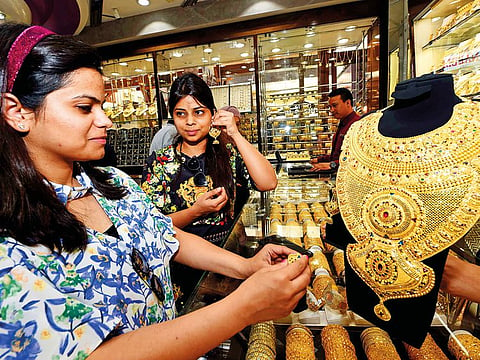Gold losing sparkle in UAE: Jewellery sales drop 23% over high prices
Precious metal records worst ever yearly demand in 2018

Dubai: Gold jewellery sales in the UAE had its worst performance ever during 2018, with higher gold prices and the VAT (value-added tax) factor forcing consumers to stay away from their favourite metal.
Demand from tourists was also weak for the better part of the year, though this did pick up slightly after the government announced VAT refunds for these shoppers from November.
In all, 36.2 tonnes of gold jewellery were sold in the UAE last year, down 23 per cent from the 46.7 tonnes recorded in 2017, according to World Gold Council numbers released Thursday.
In recent years, UAE jewellery sales have averaged in the 50-tonne plus range. During the fourth quarter of 2018, sales weighed in with 9.5 tonnes, a slight improvement on the 6.9 tonnes in Q3-18.
“The 2018 numbers for the UAE are the lowest on record for gold jewellery,” said John Mulligan, Head of Member and Market Relations at London-headquartered WGC. “A simple pricing structure was what led to Dubai assume such a significant role in the global jewellery market - with VAT, there were readjustments in that strategy.”
It could be that a good number of gold buyers in the UAE could have shifted their preferences to gold bars so as to avoid VAT, which too contributed to demand tailing off significantly for jewellery.
The first few weeks of this year have not brought about any drastic changes in gold buying patterns. In fact, “Apart from the first few days of January, demand has been weak for all jewellery categories, be it at the high-end or targetted at the budget shopper,” said Anil Dhanak, Managing Director at Kanz Jewels. “There is still buyer resistance to gold prices at a near Dh150 a gram, and that’s the price range we have had for some time now.
“Currency exchange rates too have played havoc on demand - with the Indian rupee at 20 to the dirham, tourists from India have been frugal on their gold buying. The VAT refunds have provided only small comfort so far.” (The VAT component on gold buying would be about Dh8-Dh9 on a per gram basis.)
According to Cyriac Varghese, General Manager of Sky Jewellery, “All the market technicals point to bullion prices heading for $1,350 an ounce, which would push Dubai gold rate to well above Dh150 plus a gram. Shoppers have already shown reluctance to spend at rates of Dh145-Dh149... Dh150 and more will make it less likely they would be in the mood to spend.”
But consumer sentiments were weak on gold across the region. There was a 14 per cent year-on-year drop in Saudi Arabia, and the decline was more drastic in Iram at 35 per cent. The only major exception were shoppers in Egypt, who helped push demand up by 12 per cent over 2017.
Across the rest of the world, gold remained in the good books of consumers, with jewellery sales at 2,200 tonnes, a dip of 1 tonne from 2017 levels. Chinese consumers helped with 672.5 tonnes and a 3 per cent year-on-year gain, and in the US, it was up 4 per cent. And in India, despite concerns about the direction of the economy, the decline in gold jewellery demand was only 4 tonnes to total 598 tonnes overall. “The weak rupee made domestic gold prices that much more expensive,” said Mulligan. “But on the whole, demand within India was still in solid territory.”
Meanwhile, overall demand for bullion weighed in at 4,345.1 tonnes in 2018, up 4 per cent, based on WGC numbers. This is quite in line with the five- year average demand of 4,347.5 tonnes.
So, who was doing the buying apart from those picking up jewellery? Central banks the world helped gold’s cause, with their purchases accelerating in the second-half of 2018. Overall, central banks added 651.5 tonnes to their gold reserves, a massive 74 per cent gain on 2017 levels and the “second highest yearly total on record”.
Other investors too were picking up on the gold as safe haven theme. “Professional investors were no longer shrugging off geopolitical concerns and believing in the continued vitality and record highs of US stock markets,” said Mulligan. “There were also more signs of weaknesses showing up in the global economy.”
Picking up coins and bars
At 236.4 tonnes, global demand for gold coins was at a five-year high in 2018, according to WGC. Investment in gold bars was steady at 781.6 tonnes, the “fifth year in succession of holding in a firm 780-800 tonnes range”.
This year should see more investors bulking up on their gold purchases. “Gold demand rose in 2018 and, although the US dollar gold price was down 1 per cent over the year, it outperformed many other financial assets,” said Alistair Hewitt, Head of Market Intelligence at the WGC. “Worries about a slowdown in global growth, heightened geopolitical tensions, and financial market volatility saw central bank demand hit its highest level since (former US President) Nixon closed the gold window in 1971, the volume of gold in European-listed ETFs reach a record high, and annual coin demand leap 26 per cent.”
Sign up for the Daily Briefing
Get the latest news and updates straight to your inbox



